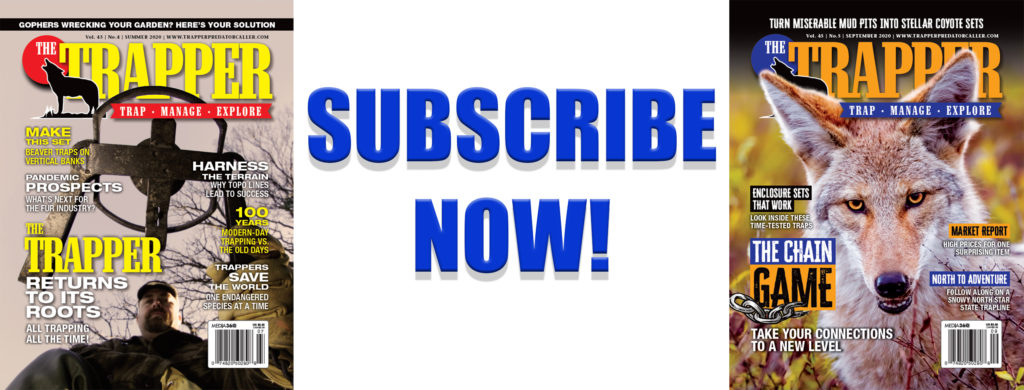There’s no doubt about it, times are tough for everyone in the fur industry, and at this time every trapper is wondering what to expect for this fall. Of course, the cold temperatures that we feel in the mornings tell us that autumn is around the corner, and the next month will be geared toward getting the final details ready for the season.
I treated my traps and snares in early August, but my fur shed is still a mess because it is used as an all-purpose fish processing house, ATV repair shop and even as a carpentry shed in the summer. Soon, I’ll have to clean it all up and get ready for fall. I am sure that most of us are thinking more and more about the season, and may have already started it, and certainly, we would all like to have at least a clue or two as to what to expect price-wise for the species we pursue. The problem is, at the time of this writing in early September, the only information we have about the market — and how it may or may not recover — is the sale that just ended at Fur Harvesters Auction in North Bay.
The operators of the auction house worked hard to maintain a sale “in-person” at their North Bay, Ontario, facility. Travel restrictions, however, impaired attendance from foreign buyers and basically limited it to Canadian fur brokers. Their report states that almost 30 buyers attended, which is good considering the COVID-19 mess and travel restrictions. But, it’s still low compared to normal years that often see in excess of 75 buyers in the same room.
Sales for taxidermy items such as bears, wolves and wolverines were promising, but the sale of the most abundant species was clearly difficult. COVID-19 has greatly reduced the world appetite for luxury goods, including fur, so active bidding on commercial goods has definitely shrunk again. Detailed prices were not provided since the auction continues online until mid-September.
Preliminary trends suggest that the market will go down yet again this year. The biggest surprise was that coyotes started to go down in price substantially, a phenomenon that the entire industry was expecting to see eventually. The trend for fur trim in parkas has been hot for a long time, but recently Canada Goose, the leading company behind this trend, announced that it would continue using coyote fur, but mainly from recycled fur coats. The buzz may be partly to blame, but likely COVID-19 also played a role in slowing down the retail market for fur-trimmed luxury winter parkas. So, if you are a coyote trapper — do not expect to receive as much for your skins in the coming year as you did last year.
Water species will have yet another very tough year because the ranch mink prices are still stalled below production cost, and the market is flooded with low-grade mink pelts from ranchers that “pelted-out,” meaning they sold their entire crop, including breeders.
Reports show that China is actively buying lower-grade ranch mink, probably to supply their factories that create garments with the hope of producing very cheap coats from poor mink skins. This is bad for us all because competition for the low-grade skins eliminates the appetite for high-quality skins. Price is the main thing, it seems, in that market, and low prices for ranch mink makes it really tough to sell our wild short-hair species like wild mink, river otters, beavers and muskrats. Without any clear information at this time, I would say expect water species to sell at levels similar to last March, or slightly lower. Nothing will suddenly rise in price for the upcoming season among those four species.
The same goes for raccoon and fox — I would say that if you can sell at levels similar to last year, go for it. We will not see an increase in interest or demand for those species. There is still a major inventory on hand and everyone would like to see clearance of the backlog. But market conditions and the COVID-19 uncertainty tells us that we will all likely experience another tough year in early 2021 when we try to sell our 2020 skins. Castoreum will sell really high, prices may reach $100 a pound for the very best, so pay attention to proper removal and drying of castoreum if you have plenty of beavers to catch.
I know that this news is depressing overall and reflects the mood of the entire industry. Retailers struggle, manufacturers struggle and brokers live on commission fees, so when no fur moves, no commissions are paid, and auction houses struggle, as well. Obviously, the trappers in the field paying gas and driving all over to catch fur, also struggle.
So, even though we are still stuck in the fog over what prices can be expected for 2021, the main thing to remember is to have fun, catch what makes you happy, focus on prime skins and do not quit your day job to become a full-time fur trapper. Call your local taxidermist if you catch something really nice, handle those castoreum glands with care, and maybe find a meat market for your beavers and raccoons. Have fun, take a few friends along, learn new sets and take pictures, this is likely another year where profits will be measured in memories instead of dollars.
By the time you receive this issue, more specific price information will be available on the Fur Harvesters Auction Inc. website at www.furharvesters.com.



